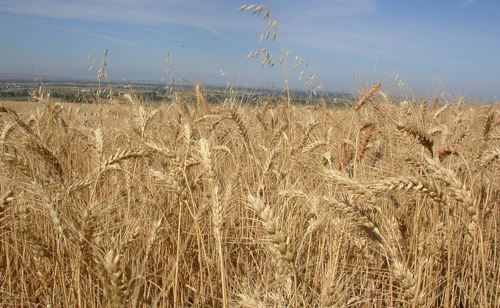Triticum urartu: Red Data Book of Armenia

EN B 1 ab(iii) + 2 ab(iii)
Category. Endangered species. It is considered close relative of the cultivated wheat species. Only one sub–population is found in the Republic. The extent of occurrence and the area of occupancy are less than 500 km2. The species faces decline of the extent of occurrence and the area of occupancy caused by changes in habitat conditions as a result of the intensity of agricultural activities. It was included in the first edition of the Red Data Book of Armenia under Category 1: Endangered species. It is not included in the Annexes of CITES and that of the Bern Convention.
Description. Annual plant. Stems prostrate, 40–100 cm. Spike 5–11 cm long; rachis dividing into articules. Spikelets up to 30, with 1 red caryopsis. Lemmas of 2 lower flowers of spikelet awned.
Distribution. In Armenia it grows only in Yerevan (neighborhoods of Voghchaberd village, “Erebuni” State Reserve) floristic region. AOO is 12 km2, the number of locations is 1. Besides Armenia the species grows in Anatolia, North Iraq, Syria and Lebanon.
Ecological, biological and phytocoenological peculiarities. Grows in middle mountain belt, at the altitudes of 1200–1600 meters above sea level, in the steppes, on stony and clay slopes. Flowering in May, fruiting in June.
Limiting factors. Restricted extent of occurrence and area of occupancy, loss/degradation of habitats caused by the expansion of arable lands, amelioration and global climate change.
Conservation actions. Part of the population grows in "Erebuni" State Reserve. Necessary: monitoring of the population state.
Suggestions
 The Ministry of Environment sent a letter international partners to draw their attention to the real danger of environmental disasters as a result of Azerbaijan's large-scale aggression towards the territory of Armenia
The Ministry of Environment sent a letter international partners to draw their attention to the real danger of environmental disasters as a result of Azerbaijan's large-scale aggression towards the territory of Armenia
 Vicia pisiformis: Red Data Book of Armenia
Vicia pisiformis: Red Data Book of Armenia
 Vavilovia formosa: Red Data Book of Armenia
Vavilovia formosa: Red Data Book of Armenia
 Trigonella capitata: Red Data Book of Armenia
Trigonella capitata: Red Data Book of Armenia
 Trigonella astroides: Red Data Book of Armenia
Trigonella astroides: Red Data Book of Armenia












